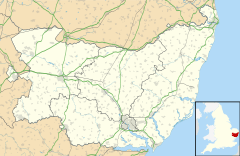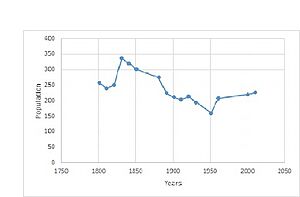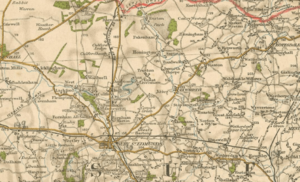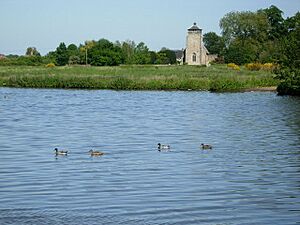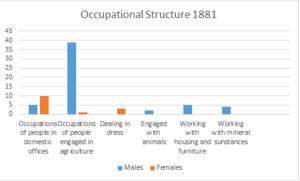Great Livermere facts for kids
Quick facts for kids Great Livermere |
|
|---|---|
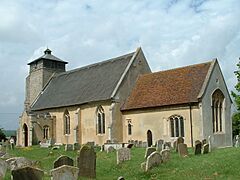 Church of St Peter |
|
| Area | 6.51 km2 (2.51 sq mi) |
| Population | 226 (2011) |
| • Density | 35/km2 (91/sq mi) |
| District |
|
| Shire county | |
| Region | |
| Country | England |
| Sovereign state | United Kingdom |
| Post town | Bury St Edmunds |
| Postcode district | IP31 |
| Police | Suffolk |
| Fire | Suffolk |
| Ambulance | East of England |
| EU Parliament | East of England |
| UK Parliament |
|
Great Livermere is a small village in Suffolk, eastern England. It's found in the West Suffolk area. The village is about four miles north-east of a bigger town called Bury St Edmunds.
Great Livermere has a village hall. This is a place where people meet and hold events for the community. In 2011, only 226 people lived here. There were 103 males and 123 females. The number of people living in the village has changed a lot over time. From 1850 to 1950, the population went down quickly. But since the 1950s, it has slowly grown.
Contents
Discovering Great Livermere's Past
What's in a Name?
The name of the village, Livermere, comes from old English words. Lēfer means "rush" or "reed," and mere means "pond" or "lake." So, Great Livermere means "Reed Lake."
Early Records and the Domesday Book
The village was first written about even before the Norman conquest of England. This was in a special document from 1051 by Edward the Confessor. He gave land here to Ely Abbey.
Later, in 1086, the Domesday Book recorded Great Livermere. This book was a huge survey of England. It said that 52 households lived in the village. They also had 3 cattle, 3 pigs, and 100 sheep.
The Historic St Peter's Church
The village has a very old church called St Peter's. It's so important that it's listed as a Grade I building. Inside, you can see old wall paintings and a special three-level pulpit. It also has one of the best organs in the area. A famous person named William Sakings is buried there. He was a falconer, someone who trains falcons, for three different kings: Charles I, Charles II, and James II.
Old Descriptions of the Village
What Writers Said in the Past
In the late 1800s, some writers described Great Livermere. In 1870–72, a writer named John Marius Wilson wrote about it. He said the village was 3.5 miles west of Ixworth. It had a post office and about 1,549 acres of land. The population was 290 people living in 64 houses.
He also mentioned Livermere Hall, a large house. It used to belong to the Duke of Grafton. The church was described as a small building with a tower and a thatched roof.
Later, in 1887, John Bartholomew wrote a shorter description. He said Great Livermere was a parish and village in Suffolk. It was 5 miles north-east of Bury St Edmunds. He noted it had 1,549 acres and a population of 275.
Great Livermere in Stories
A Village of Inspiration
The famous ghost story writer M. R. James lived in Great Livermere. His father was the Rector, or head priest, of the village church. From the age of three in 1865 until 1909, James's home was the Rectory. This village inspired the setting for A Vignette, which was his very last supernatural story.
Livermere Hall was a large country house nearby. It was torn down in 1923. People think it inspired the made-up Castringham Hall in James's ghost story "The Ash-tree". This story was published in 1904. Also, the last name of a ghostly character, "Mothersole," can be found on gravestones in the churchyard. The old Rectory where M. R. James lived is now called "Livermere Hall."
Village Life and Health
Community Health in Great Livermere
According to official numbers, most people in Great Livermere are Christian. There are 135 Christians and 70 people who say they have no religion.
When it comes to health, most people in Great Livermere are very healthy. About 45.6% of people have "very good health." Another 28.3% have "good health." Only a small number, 1.8%, have "very bad health." This shows that the village generally has good health.
Jobs in the Village
Work in the Past and Present
In 1881, there was a big difference in the types of jobs men and women did in Great Livermere. For example, twice as many women worked in domestic jobs, like household services. But in farming, there were 39 men for every 1 woman. Farming was clearly the main job for people back then.
Men were also the only ones who worked with animals, like game-keeping. And women were the only ones who worked with clothes, like tailoring. This shows how different the jobs were for men and women in 1881.
Today, things have changed a lot. In 2011, the main jobs were in manufacturing and health and social care. While farming is still part of life in this small countryside village, many people now work in modern industries like production and retail.
Economy and Homes
How People Work and Live
In 2011, 165 people aged 16–74 lived in Great Livermere.
- 62 people worked full-time.
- 21 people worked part-time.
- 31 people were retired.
The rest of the people either cared for sick or disabled family members or were not working for other reasons.
When it comes to homes, bungalows are the most common type of housing in Great Livermere.
- 35 homes are detached houses (standing alone).
- 61 homes are semi-detached (two homes joined together).
- 100 homes are bungalows (single-story houses).
The remaining homes are apartments or mobile homes. This suggests that many homes in the village might be suitable for an older population.
Getting Around Great Livermere
Travel in the Village
Most people in Great Livermere use cars and vans to get to work. In 2011, 82 people used a car or van for their commute. Only 4 people used a coach or bus. This shows that public transport might not be very good in this countryside area. Many people work from home instead of traveling outside the village. Others walk or ride bicycles.
Famous People from Great Livermere
- M. R. James: He was an English author famous for his ghost stories. He was also a scholar who studied the Middle Ages. He led King's College, Cambridge, and Eton College.
- Thomas Clerke (MP): He was a Member of the English Parliament in 1547.
- William Buckenham: He was a priest and academic in the 1500s.


